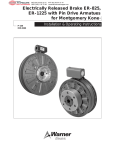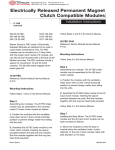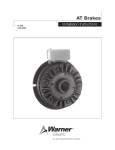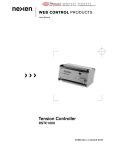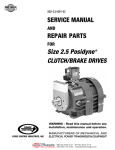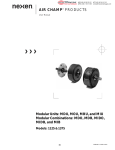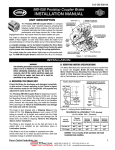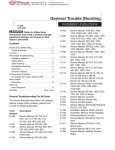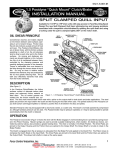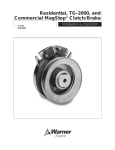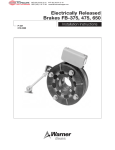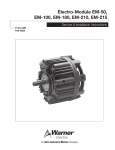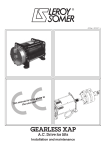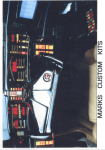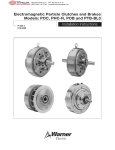Download 819-0121_P-251-HIres
Transcript
MEX (55) 53 63 23 31 DIST. AUTORIZADO QRO (442) 1 95 72 60 ® MTY (81) 83 54 10 18 [email protected] Electrically Released Brakes ER 825 and 1225 Heavy Duty P-251 819-0121 Installation Instructions An Altra Industrial Motion Company MEX (55) 53 63 23 31 DIST. AUTORIZADO QRO (442) 1 95 72 60 ® MTY (81) 83 54 10 18 [email protected] This service manual tells how to install, adjust, and maintain your Warner Electric brake. It also contains information for part replacements when needed. Warner Electric Electrically Released Brakes are high performance, high torque units. To obtain the required performance and life, the brake must be installed exactly in accordance with the instructions in this service manual. The Warner Electric warranty does not apply to any unit which is not installed, used, operated and maintained in accordance with Warner Electric's instructions. Contents Introduction . . . . . . . . . . . . . . . . . . . . . . . . . . . . . . . . . . . . . . . . .2 Installation Instructions . . . . . . . . . . . . . . . . . . . . . . . . . . . . . . . .3 Controls Used . . . . . . . . . . . . . . . . . . . . . . . . . . . . . . . . . . . . . . .5 Ohmmeter Procedure to Detect Armature Release . . . . . . . . . . .8 Coil Data . . . . . . . . . . . . . . . . . . . . . . . . . . . . . . . . . . . . . . . . . . .8 MCS-805-1, MCS-805-2 Mounting Dimensions . . . . . . . . . . . . .8 Operating Instructions . . . . . . . . . . . . . . . . . . . . . . . . . . . . . . . . .9 Dimensions and Specifications . . . . . . . . . . . . . . . . . . . . . . . . .11 Bushing Part Numbers . . . . . . . . . . . . . . . . . . . . . . . . . . . . . . . .12 Exploded View . . . . . . . . . . . . . . . . . . . . . . . . . . . . . . . . . . . . . .13 Parts List . . . . . . . . . . . . . . . . . . . . . . . . . . . . . . . . . . . . . . . . . .13 Warranty . . . . . . . . . . . . . . . . . . . . . . . . . . . . . . . . . . . . . . . . . .BC ER-825 and ER-1225 Introduction Warner Electric Electrically Released Brakes function on the same principle of "response to magnetic attraction" that operates other Warner Electric brakes and clutches. Braking torque in the Electrically Released Brake depends on permanent magnets rather than electromagnets. With the power off, the unit produces full braking torque. The brake is released by reversing the direction of flux flow in an electromagnetic coil, thus opposing the field produced by the permanent magnets. The opposition to and cancellation of electromagnetic force which releases the brake occurs nominally at one value of ampere turns. This ampere turn value can vary among brakes because of allowable manufacturing tolerances. 2 Warner Electric • 800-825-9050 Release voltage varies mainly because of coil tolerance and autogap spring variations. Properly adjusting the power supply voltage is important so the autogap springs will separate the magnet and armature, causing full release of the brake. Ceramic permanent magnets, which are the heart of Electrically Released Brakes, are not subject to fatigue losses, therefore, Warner Electric Electrically Released Brakes are self-adjusting. Warner Electric Electrically Released Brakes are “burnished” at the factory to assure rated torque shortly after initial application. Very little additional wear-in is required. P-251 • 819-0121 MEX (55) 53 63 23 31 DIST. AUTORIZADO QRO (442) 1 95 72 60 ® MTY (81) 83 54 10 18 [email protected] Sizes ER-825 and ER-1225 with Spline Drive Armatures Installation Instructions Failure to follow these instructions may result in product damage, equipment damage, and serious or fatal injury to personnel. Basic Mechanical Considerations Electrically released brakes require special mounting considerations. Please review the items listed below prior to starting installation contained in steps 1-12. A. If the brake magnet is to be mounted to a surface of magnetic material, isolate the brake approximately 1/2 inch from the surface with a plate or spacer of nonmagnetic material. B. If a choice of armature shaft material exists, this should also be nonmagnetic. Materials such as type 302-304 stainless have been used very successfully. C. In order to minimize stray flux, the unit should be exposed as much as possible or, if enclosed, it should be placed in a housing of nonmagnetic material such as stainless steel or aluminum. D. Note: Failure to set control voltage using the step by step procedures in this manual may cause overheating and premature failure. Section 1 Step 1: Check to insure that the magnet and its mounting surface are clean and free from burrs. Step 2: Bolt the magnet in place with capscrews and lockwashers. Note: The magnet pilot diameter must be concentric to the shaft within .010 inch T.I.R. The magnet mounting surface must be square with the shaft within .006 inch T.I.R. measured at the bolt circle. Step 3: Assemble the splined armature assembly (armature, splined armature adapter and autogap are preassembled) to the hub. New armatures shipped from the factory are flat to within .005 inch and this flatness must be retained to maintain full torque. Any attempt to pry the armature loose from the magnet will distort the armature. When adjusting the armature position, apply any required force only to the hub, not to the outer edge of the armature. Also, use care when handling the armature as dropping may also cause distortion. must be exercised when the armature is moved close to the magnet assembly since the permanent magnets create a very strong attractive force. Injury may result if fingers are in between the armature and magnet when the gap is 1/2" or less. E. Foreign Materials: If units are used on machinery where fine, abrasive dust, chips, oil or grit are dispelled into the atmosphere, a protective screen over the unit may be necessary. Where units are used near gear boxes or transmissions requiring frequent lubrication, means should be provided to protect the friction surfaces from oil and grease to prevent serious loss of torque Applications requiring a vertical shaft mounting must be reviewed and approved by Warner Electric Applications Engineering. Warner Electric • 800-825-9050 Figure 1 Step 3A: Place the armature-splined adapter assembly on a flat surface, segments up. Press the splined hub (retainer ring end first) through the autogap spring and splined armature adapter. P-251 • 819-0121 3 MEX (55) 53 63 23 31 DIST. AUTORIZADO QRO (442) 1 95 72 60 ® MTY (81) 83 54 10 18 [email protected] Slip the armature hub assembly onto the brake shaft until armature makes contact with shims. Step 5: Using a hex wrench, tighten the hub bushing bolts alternately and evenly until tight. Using a drift and small hammer, tap lightly at several points around the circumference of the taper lock bushing. Repeat this alternate tapping and re-tightening until the specified torque is reached and wrench no longer turns the screw after tapping. Tighten bolts to the following: Figure 2 Step 3B: Turn the assembly over and insert the retainer ring in the groove. Take care not to bend or distort retainer ring. Step 3C: Turn the assembly over and slide the armature against the retainer ring. During steps 4 through 7, handle the armature/hub assembly by the hub (Figure 3, item 2) only, making sure the armature (Figure 3, item 3) is as close to the retainer ring (Figure 3, item 4) as possible. Any movement of the armature on the splined hub will reduce available armature travel and may cause improper setting of the running air gap. Unit ER-825 ER-1225 Torque 87 in. lb. 290 in. lb. Do not attempt to pull the bushing flange flush with the hub end as there should be 1/8” to 1/4” clearance when tightened. The airgap between armature and magnet must be .062 to .125 inch. If the airgap is outside of that range, reposition the armature hub assembly by repeating steps 1 and 2 of the disassembly procedure and steps 4 and 5 of the assembly procedure. .062" Thick Steel Shims 1 3 1/16 inch thick steel shims are recommended for shim stock selection. Do not use shims thicker than 1/8 inch or you will shorten brake life by reducing available armature travel. Shim stock must be clean and free of any contamination (oil, grease). Keep fingers clear of the area between the magnet and the armature as the armature will be pulled sharply toward the magnet after the gap is closed to approximately 1/2 inch. Bushing Type Browning Series H Browning Series Q 5 4 1 2 3 4 – – – – Magnet Splined Hub Armature Spiral Retainer Ring 5 – Bushing 2 Friction Material Step 4: Place three steel shims 120 degrees apart on the magnet as shown in Figure 3. Insert the taper-lock bushing (Figure 3, item 5) into the hub (Figure 3, item 2). Figure 3 4 Warner Electric • 800-825-9050 P-251 • 819-0121 MEX (55) 53 63 23 31 DIST. AUTORIZADO QRO (442) 1 95 72 60 ® MTY (81) 83 54 10 18 [email protected] Step 6: Electrical Connections. Several different types of controls can be used on the ER-825. However, only one control can be used on the ER-1225 electrically released brakes. If you are installing an ER-825 brake, follow the procedures in Section I below. When completed with Section I, proceed to Step 7. If you are installing an ER-1225, follow the procedures in Section II below. When completed with Section II, proceed to Step 7. Section I For ER-825 Brakes ER-825 brakes require a variable voltage or variable current control to release the brake by offsetting the magnetic force generated by permanent magnets. Warner Electric controls, such as the CBC-200 (single channel) or CBC-300 (dual channel), offer variable output and are suitable for use with ER-825 brakes. Connection should be made in accordance with instructions provided with the chosen control. Section II For ER-1225 Brakes Connect the MCS-805-1 or MCS-805-2 Power Supply per the following diagram and instructions: 3 4 5 (-) Brake 6 (+) 7 B. A chassis ground should be provided as a non-current conducting ground wire (color coded green). C. Switching. Follow instructions per control models listed. MCS-805-1 Standard Control Operation 1. For switching DC side: Switch connected to terminals 7 and 8. Switch open will allow brake to be engaged. Switch closed will enable the release of the brake. 2. For switching AC side: Line power off will allow brake to be engaged. Line power on will release brake. A jumper connection must be made between 7 and 8. MCS-805-2 Two Step Control Operation MCS 805-2 3 230 VAC supply to terminals 1 and 4. Jumper to connect terminal 2 with terminal 3. Recommended fuse is 3/4A slow blow. 8 Brake Release 115 VAC 2 or: 3. Slower brake actuation will result when switching the AC side. MCS 805-1 2 A. 115 VAC supply to terminals 1 and 4. Jumpers to connect terminal 1 with terminal 2 and terminal 3 with terminal 4. Recommended fuse is 3/4A slow blow. 4 5 6 7 8 (+) (-) 230 VAC Brake Coil Brake Release ER brakes are polarity sensitive. Connect the “+” terminal of the brake to the “+” terminal of the control and the “-” terminal of the brake to the “-” terminal of the control. Plus to plus and minus to minus connections are imperative. Put machine in safe condition so that when voltage is applied to the control and switch closures are made the brake does not rotate and machine does not run. Warner Electric • 800-825-9050 1. With switch connected to terminals 7 and 8 and switch is open with AC power applied, brake will be partially engaged. 2. With switch connected to terminals 7 and 8 and switch is closed with AC power applied, brake will be fully released. 3. With switch connected to terminals 7 and 8 and switch closed with AC power removed, brake will be fully engaged. D. ER brakes are polarity sensitive. Connect the plus terminal of the brake to terminal 6 on the control and the minus terminal of the brake to terminal 5 on the control. P-251 • 819-0121 5 MEX (55) 53 63 23 31 DIST. AUTORIZADO QRO (442) 1 95 72 60 ® MTY (81) 83 54 10 18 [email protected] Step 7: Apply power to the brake and remove shims. Note: It may be required at this point to adjust voltage to brake, to release the armature and remove shims. Set the airgap by pressing the armature into contact with the magnet and then releasing. (See Figure 3) The armature should spring back approximately 1/32-3/64 (.031-.045) inch. If the airgap is outside of that range, reposition the armature hub assembly by procedure Section III and steps 4 and 5 of the assembly procedure Section I. Note: If armature does not engage it may be necessary to manually engage the armature by pressing on the back side of the armature keeping fingers from between armature and magnet. 9D. After armature is engaged, slowly decrease (counter clockwise) the voltage adjust to the brake until the brake armature releases. Record this voltage. 9E. Note: If armature does not spring back proceed to voltage adjust procedure. Step 8: Brake Release Voltage Adjustment. When setting the brake power supply, the objective is to achieve armature release by adjusting the coil voltage so it counteracts the permanent magnet to the maximum extent possible. Two different release procedures are used, depending on whether an ER-825 or ER-1225 is involved. For ER-825 brakes, follow the procedures outlined in Step 9 below. For ER-1225 brakes, follow the procedures outlined in Step 10. Step 9: For ER-825 Brakes Note: If the autogap is not used, an external release force of approximately 5-10 pounds should be applied by hand, to detect the point of armature release. Note: If the above voltage adjustment procedure can not be observed visually the alternate ohmmeter procedure should be used. Section IV. Step 10: For the ER-1225, the procedure is the same as Step 9 with the exception of the control used. Put machine in a safe condition so that when voltage is applied to control and switch closures are made the brake does not rotate and machine does not run. The only two controls to be used are the MCS 805-1 or MCS 805-2, the voltage adjust is performed by adjustment screw only, located on inside of control. 9A. 10A. Follow Step 9 for adjustment of brake control for ER-1225. 9B. Attach multimeter to brake to monitor DC voltage observing proper procedure for hookup of multimeter per manufacturing instruction. Apply power to control and close switch connections that allow DC voltage from control to be applied to brake. 9C. Depending on variable control used and output channel that brake is hooked up to, turn voltage adjust knob or screw, counter clockwise to 0VDC, at this point slowly increase voltage control clockwise until brake armature disengages. (Releases) Record this voltage, continue to increase voltage until brake armature engages. 6 The final voltage setting for the brake should be the mid point between the voltages recorded in Step 9C and 9D. Warner Electric • 800-825-9050 10B. (For MCS-805-2 only): Set partial engagement torque using adjusting pot at top of control. Switch connected to terminals 7 and 8 must be open to make this adjustment. A setting of 10 gives maximum torque. After completion of installation procedure and brake control adjustment it may be necessary to burnish (wear in) the brake in the application. P-251 • 819-0121 MEX (55) 53 63 23 31 DIST. AUTORIZADO QRO (442) 1 95 72 60 ® MTY (81) 83 54 10 18 [email protected] Note: The brake is pre-burnished at the factory but during the installation and handling of the brake, static torque may have been affected. Therefore, burnishing on site is recommended. Step 11: Burnish the brake as follows: This step requires you to run the machine that brake is used in. Observe all safety rules and regulations for your facility. Using the brake as the primary stop device, start and stop the brake 30 times. Allow 5-10 seconds delay between Start and Stop. During torque measurements machine power should be turned off and properly locked out. Step 12: With the brake fully engaged, attach torque wrench to the end of the brake shaft. Hold the wrench at the handle, and pull it in the direction of motor rotation in one continuous motion (without any jerky motion) until shaft movement is detected. The highest reading on the dial is the static torque of the brake. This torque without any system drag must be at least 400 lb. ft. for ER-1225 and 125 lb. ft. for ER-825. If less, burnish the brake again, repeating Step 11. If the brake does not meet the torque requirement after two burnishing procedures, replace the brake. The brake installation procedure is now complete. Section III Disassembling the Armature/Hub Assembly (Figure 3) Do not pry the armature away from the magnet. If armature is distorted the entire brake must be replaced. Note: Steps (1) and (2) are to be performed at the brake. Note: Make sure power to the brake is turned off. See Figure 3 for the following two steps. Put machine in a safe condition so that when voltage is applied to control and switch closures are made the brake does not rotate and machine does not run. Step 1: Loosen the taper-lock bushing (item 5) on the brake shaft. To loosen, remove both hex screws from the taper lock bushing (item 5, figure 3) using a hex wrench. Insert the hex screws into the previously vacant taped holes in the taper lock bushing and tighten these screws until the bushing is loosened in the hub (item 2). If the bushing does not loosen, tap on the bushing with a drift and small hammer. Step 2: Apply power to the brake. The armature will then spring away from the magnet. If it does not, check electrical connections and release voltage. Remove taper lock bushing (item 5) and armature assembly (items 2 & 3) from the brake shaft. Set the bushing aside. Do not discard the bushing. Note: If reinstalling armature assembly, follow steps 1 thru 7 in the assembly procedure. Warner Electric • 800-825-9050 P-251 • 819-0121 7 MEX (55) 53 63 23 31 DIST. AUTORIZADO QRO (442) 1 95 72 60 ® MTY (81) 83 54 10 18 [email protected] Section IV Ohmmeter Procedure to Detect Armature Release When the brake armature cannot be visually observed during brake voltage adjustment, an ohmmeter can be used to determine when the armature disengages. One ohmmeter lead should be attached to the armature itself, in a manor not to obstruct the movement of the armature the other to the machine base. The release point can be determined as follows: 2. The brake is disengaged (released) when the ohmmeter indicates higher resistance (usually greater than one ohm—may be as high as 10,000 ohms). The difference between ohmmeter readings 1 and 2 must be large enough to reliably indicate armature engagement or disengagement. Reliable readings can usually be obtained from a brake mounted on a shaft running on antifriction bearings. Put machine in a safe condition so that when voltage is applied to control and switch closures are made the brake does not rotate and machine does not run. Coil Data Unit Size 1. The brake is engaged when the armature contacts the magnet, causing very low resistance (less than one ohm). Current Draw (amp) at 60 Volts D.C. Resistance (ohms) at 20°C (±10%) ER-825 .308 195 ER-1225 .256 235 MCS-805-1 and MCS-805-2 Power Supply Dimensional Drawings and Mounting Provisions TOP AND BOTTOM 3.44 1.125 0.875 Diameter Knockouts for 0.50 Conduit Both Ends Typical 2.625 FRONT 0.28 Diameter (4) Mtg Holes Clearance for .25" Screw SIDE 7.125 BACK 6.0 0.56 5.0 8 Warner Electric • 800-825-9050 3.44 0.53 3.75 4.81 5.0 P-251 • 819-0121 MEX (55) 53 63 23 31 DIST. AUTORIZADO QRO (442) 1 95 72 60 ® MTY (81) 83 54 10 18 [email protected] Operating Instructions When an Electrically Released Brake is properly installed, no further servicing, lubrication, or maintenance should be required throughout the life of the unit. A worn out Electrically Released Brake can lose its ability to produce adequate torque. Consequently, it is imperative that the brake be inspected frequently for wear and to insure that it engages and disengages properly. The frequency of inspections is dictated by usage; a brake used in a high cycle rate and/or heavy load application must be inspected more often than one used less severely. Sound maintenance practices will determine proper inspection intervals. Torque loss can result if the armature and magnet wear extensively enough to cause the detent to move off the end of the hub spline, resulting in a loss of the autogap function. The end of normal service will occur when the armature wears through the friction material and into the coil, causing an open circuit and failure to release when voltage is applied. Brake wear is determined by two checks. The first determines whether the brake is about to lose torque; the second assures that the armature has not worn through the friction material, endangering the coil. If either of these checks indicates excessive wear, the unit should be replaced. Check No. 1 Check to insure that the distance from the retaining ring to the splined adapter is less than 5/16 inch (see Check No. 1). This 5/16 inch dimension can also be exceeded if the splined hub is improperly positioned on the hub at installation. If the 5/16 inch dimension is exceeded, the armature must be readjusted. Disassemble per Section III Steps 1 and 2, and relocate brake armature as indicated starting with step 1-7. Warner Electric • 800-825-9050 Wear Step Indicator Magnet Armature 0.31 (7.9) Snap Ring Adapter Taper Lock Bushing Splined Hub Check No. 1 Check No. 2 The remaining wear life of the friction surfaces can be estimated by checking the step machined on the O.D. of the brake magnet where the armature and magnet meet. This step is approximately equal to the friction material thickness. When this step is completely covered by the armature (worn down) with the brake engaged, the brake is worn out and should be replaced. New (Step) Magnet Worn to Step New Worn Out Check No. 2 Note: A new splined hub should also be installed when the armature and magnet are replaced. Reusing the old splined hub or armature adapter may prevent the armature from fully engaging the magnet, resulting in torque loss. Foreign Materials: If units are used on machinery where fine, abrasive dust, chips, oil or grit are dispelled into the atmosphere, a protective screen around the unit is necessary. Where units are used near gear boxes or transmissions requiring frequent lubrication, means should be provided to protect the friction surfaces from oil and grease contamination (contact) to prevent serious loss of torque by reducing the coefficient of friction P-251 • 819-0121 9 MEX (55) 53 63 23 31 DIST. AUTORIZADO QRO (442) 1 95 72 60 ® MTY (81) 83 54 10 18 [email protected] and swelling the friction material. Small amounts of oil and grease accidentally reaching the friction surfaces may be removed by wiping with a rag dampened with a non petroleum, non residue cleaning solution. In performing this operation, do not drench the friction material. If the friction material has been saturated with oil or grease, no amount of cleaning will be completely effective. Once such a unit has been placed back in service, heat will cause the oil to be boiled to the surface resulting in further torque loss. This unit should then be replaced! Fails to Release: If an Electrically Released Brake does not release, the initial check should be to verify the electrical connections (polarity) between the brake coil and power supply. If the lead wires are connected properly power supply positive “+” terminal and brake coil “+” terminal, and power supply negative “-” terminal and brake coil “-” terminal, the next check is to see that the brake release voltage adjustment is properly set in accordance with installation instructions (See Table of Contents). If readjustment of the control output does not release the brake and an AC input to the control is present, a further check should be made to determine if the control is faulty as follows: Put machine in a safe condition so that when voltage is applied to control and switch closures are made the brake does not rotate and machine does not run. Connect a DC voltmeter across the brake magnet terminals. (Do not disconnect the leads to the terminals.) Turn the torque adjustment on the control fully counterclockwise, then slowly turn the adjustment screw clockwise—the voltmeter should indicate a voltage range from approximately 30 to 75 volts for the MCS-805 series and 0 to 90 volts using other variable supplies. Wear Pattern NEW BURNISHED To determine if there is current flow through the magnet coil, further checks may be made as follows: a low-range (.1 to 1 amp) amp meter should be connected in series with one wire to the magnet. The Coil Data chart (pages 8) lists the correct ratings for the various sizes. These readings are with the power on and the brake release adjustment turned clockwise, until a voltmeter attached to the brake magnet terminals reads 60 VDC. If no amperes are read, an Ohm reading of the magnet coil should be taken. Ohmmeter checks should be made with the power off and circuit open (To be certain, disconnect one lead wire to the coil). Refer to the Coil Data chart (page 8) for the specifications of the appropriate unit. A very high or infinite resistance reading would indicate an open coil. Wear Pattern: (Figure 4) As the brake is used wear grooves will appear on the friction surfaces. This is a normal condition, and does not impair functioning of the unit. Never machine the friction surfaces to remove grooves or score marks resulting from normal wear. There are two main wear parts, magnet and armature. When either is worn out, the complete brake must be replaced. Heat: Excessive heat and high-operating temperatures are causes of rapid wear. Air should be allowed to circulate around the unit as efficiently as possible, especially if the application requires fast, repetitive cycle operation. If the above checks indicate that the proper voltage and current is being supplied to the coil, mechanical parts should be checked to assure that they are in good operating condition and properly installed. (See operating instruction under Check No. 1.) WORN Figure 4 10 Warner Electric • 800-825-9050 P-251 • 819-0121 MEX (55) 53 63 23 31 DIST. AUTORIZADO QRO (442) 1 95 72 60 ® MTY (81) 83 54 10 18 [email protected] Dimensions and Specifications ER-825 Heavy Duty Drawing I-25578 ER-1225 Heavy Duty Drawing I-25620 ER-825 & ER-1225 Magnet View K J Removable plug in ends for .5" conduit I A Q R Pilot Dia. V G H B D E C L N P Mounting holes are within 0.005 of true position relative to pilot diameter S dia. (T) holes equally spaced on U dia. O B Dia. C D E G ER Size A Max. 825 H.D. 8.656 2.5 .156 1.250 1.765 5.625 1225 H.D. 12.671 4.093 .234 2.5 2.171 7.671 H Max. I J K Min. L Min. N ER Size 825 H.D. .531 5/16-18 UNC-3A 1.687 1.546 .062 .531 1225 H.D. .546 5/16-18 UNC-3A 1.718 1.546 .062 .562 O ER-825 H.D. 2.078 P Max. 3.546 ER-1225 H.D. 2.50 5.031 Warner Electric • 800-825-9050 Q 3.750 R Max. 6.75 3.750 8.79 S T U V .358 .338 .358 .338 6 4.250 6 7.250 3.503 3.501 6.378 6.376 P-251 • 819-0121 11 MEX (55) 53 63 23 31 DIST. AUTORIZADO QRO (442) 1 95 72 60 ® MTY (81) 83 54 10 18 [email protected] Technical Ratings Bushing Part Numbers Static Torque Max. RPM D.C. Voltage Total Weight ER-825 125 lb. ft. 3600 90 15.6 lbs. ER-1225 400 lb. ft. 3000 35 to 75 60.3 lbs. Size ER-825, 1225 ER-825 Voltage–DC 90 Resistance @ 20°C–Ohms 304 Current–Amperes .29 Watts 26 Coil Built-up–milliseconds 400 Coil Decay–milliseconds 20 ER-1225 35-75 235 .383 35 700 20 Bore Size ER-825 H.D. Drive Spline Drive ER-1225 H.D. Drive Spline Drive Bore Dia. Keyway Bore Dia. .500-.562 1/8 x 1/16 .750-.875 Keyway 3/16 x 3/32 .375-.625 3/16 x 3/32 .937-1.250 1/4 x 1/8 .937-1.187 1/4 x 1/8 1.312-1.375 5/16 x 5/32 1.250* 1/4 x 1/8 1.437-1.750 3/8 x 3/16 5/16 x 5/32 1.812-2.062 1/2 x 1/4 3/8 x 3/16 2.125-2.250* 1/2 x 1/4 2.312-2.687* 5/8 x 5/16 1.312-1.375* 1.437-1.500* * Furnished with key. Customer Shall Maintain: 1. Squareness of magnet mounting face with armature shaft within .006 T.I.R. 2. Concentricity of magnet mounting pilot diameter with armature shaft within .010 T.I.R. 3. If Magnet mounting surface is a magnetic material, the magnet is to be insulated approximately 1/2 inch from that surface with a plate or spacer of non-magnetic material. 12 Warner Electric • 800-825-9050 Browning Bushing Bushing Number Shaft Size Keyway Size Warner Electric Browning 1/2 9/16 5/8 11/16 3/4 13/16 7/8 15/16 1 1-1/6 1-1/8 1-3/16 1-1/4 1-5/16 1-3/8 1-7/16 1-1/2 3/4 13/16 7/8 15/16 1 1-1/16 1-1/8 1-3/16 1-1/4 1-5/16 1-3/8 1-7/16 1/8 x 1/16 1/8 x 1/16 3/16 x 3/32 3/16 x 3/32 3/16 x 3/32 3/16 x 3/32 3/16 x 3/32 1/4 x 1/8 1/4 x 1/8 1/4 x 1/8 1/4 x 1/8 1/4 x 1/8 1/4 x 3/16 5/16 x 7/32 5/16 x 7/32 3/8 x 1/4 3/8 x 7/32 1/2 x 3/8 1/2 x 3/8 1/2 x 3/8 1/2 x 3/8 1/2 x 3/8 1/2 x 3/8 1/2 x 3/8 1/2 x 3/8 1/2 x 3/8 1/2 x 3/8 1/2 x 3/8 1/2 x 3/8 180-0002 180-0003 180-0004 180-0005 180-0006 180-0007 180-0008 180-0009 180-0010 180-0011 180-0012 180-0013 180-0014 180-0015 180-0016 180-0017 180-0018 180-0026 180-0027 180-0028 180-0029 180-0030 180-0031 180-0032 180-0033 180-0034 180-0035 180-0036 180-0037 H-1 1-1/2 1-9/16 1-5/8 1-11/16 1-3/4 1-13/16 1-7/8 1-15/16 2 2-1/16 2-1/8 2-3/16 2-1/4 2-5/16 2-3/8 2-7/16 2-1/2 2-9/16 2-5/8 2-11/16 1/2 x 3/8 1/2 x 3/8 1/2 x 3/8 1/2 x 3/8 1/2 x 3/8 1/2 x 3/8 1/2 x 3/8 1/2 x 3/8 1/2 x 3/8 1/2 x 3/8 1/2 x 3/4 1/2 x 23/32 1/2 x 11/16 5/8 x 5/16 5/8 x 5/16 5/8 x 5/16 5/8 x 5/16 5/8 x 5/16 5/8 x 5/16 5/8 x 5/16 180-0038 180-0039 180-0040 180-0041 180-0042 180-0043 180-0044 180-0045 180-0046 180-0047 180-0048 180-0049 180-0050 180-0051 180-0052 180-0053 180-0054 180-0055 180-0056 180-0057 H-2 QI-1 QI-2 P-251 • 819-0121 MEX (55) 53 63 23 31 DIST. AUTORIZADO QRO (442) 1 95 72 60 MTY (81) 83 54 10 18 [email protected] ® Exploded View I-25578 I-25620 7 6 4 2 6-1 5 3 1 Parts List ER-825 Heavy Duty ER-1225 Heavy Duty Item 1 2 3 5 4&6 6-1 7 Electrically Released Brake Electrically Released Brake Description *Bushing Retainer Ring Splined Hub Mounting Accessory, I.M. Magnet ( I.M., 90 Volt) and Armature (sold only in matched pairs) Terminal Accessory Conduit Box Per I-25578 Per I-25620 ER-825 Heavy Duty Part Number 180-0002-180-0018 1/2" to 1-1/2" Bore 748-0006 540-0057 5321-101-001 ER-1225 Heavy Duty Part Number 80-0026-180-0057 3/4" to 2-11/16" Bore 748-0005 540-0064 5321-101-001 5250-25 5311-101-001 5200-101-010 5252-4 5311-101-001 5200-101-010 Qty. 1 1 1 1 1 1 1 How to order: 1. Specify bore size. 2. Specify Heavy Duty. Example: ER-825 Electrically Released Brake per I-25578. Heavy Duty, 7/8" bore. Warner Electric • 800-825-9050 P-251 • 819-0121 13 MEX (55) 53 63 23 31 DIST. AUTORIZADO QRO (442) 1 95 72 60 ® MTY (81) 83 54 10 18 [email protected] Warranty Warner Electric LLC warrants that it will repair or replace (whichever it deems advisable) any product manufactured and sold by it which proves to be defective in material or workmanship within a period of one (1) year from the date of original purchase for consumer, commercial or industrial use. This warranty extends only to the original purchaser and is not transferable or assignable without Warner Electric LLC’s prior consent. Warranty service can be obtained in the U.S.A. by returning any defective product, transportation charges prepaid, to the appropriate Warner Electric LLC factory. Additional warranty information may be obtained by writing the Customer Satisfaction Department, Warner Electric LLC, 449 Gardner Street, South Beloit, Illinois 61080, or by calling 815-389-3771. A purchase receipt or other proof of original purchase will be required before warranty service is rendered. If found defective under the terms of this warranty, repair or replacement will be made, without charge, together with a refund for transportation costs. If found not to be defective, you will be notified and, with your consent, the item will be repaired or replaced and returned to you at your expense. This warranty covers normal use and does not cover damage or defect which results from alteration, accident, neglect, or improper installation, operation, or maintenance. Some states do not allow limitation on how long an implied warranty lasts, so the above limitation may not apply to you. Warner Electric LLC’s obligation under this warranty is limited to the repair or replacement of the defective product and in no event shall Warner Electric LLC be liable for consequential, indirect, or incidental damages of any kind incurred by reason of the manufacture, sale or use of any defective product. Warner Electric LLC neither assumes nor authorizes any other person to give any other warranty or to assume any other obligation or liability on its behalf. WITH RESPECT TO CONSUMER USE OF THE PRODUCT, ANY IMPLIED WARRANTIES WHICH THE CONSUMER MAY HAVE ARE LIMITED IN DURATION TO ONE YEAR FROM THE DATE OF ORIGINAL CONSUMER PURCHASE. WITH RESPECT TO COMMERCIAL AND INDUSTRIAL USES OF THE PRODUCT, THE FOREGOING WARRANTY IS IN LIEU OF AND EXCLUDES ALL OTHER WARRANTIES, WHETHER EXPRESSED OR IMPLIED BY OPERATION OF LAW OR OTHERWISE, INCLUDING, BUT NOT LIMITED TO, ANY IMPLIED WARRANTIES OF MERCHANTABILITY OR FITNESS. Some states do not allow the exclusion or limitation of incidental or consequential damages, so the above limitation or exclusion may not apply to you. This warranty gives you specific legal rights and you may also have other rights which vary from state to state. Changes in Dimensions and Specifications All dimensions and specifications shown in Warner Electric catalogs are subject to change without notice. Weights do not include weight of boxing for shipment. Certified prints will be furnished without charge on request to Warner Electric. Warner Electric LLC 449 Gardner Street • South Beloit, IL 61080 815-389-3771 • Fax: 815-389-2582 www.warnerelectric.com An Altra Industrial Motion Company P-251 • 819-0121 12/07 Printed in USA














